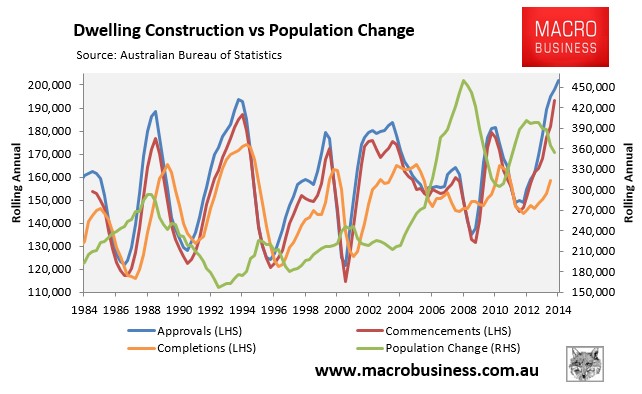Fitch is the latest to question the view that Australia has a housing shortage, noting the following today via The ABC:
Fitch’s conclusion was that the Australian housing market did not appear to be undersupplied, contrary to what housing industry groups and many independent analysts have argued.
However, neither was Australia’s housing market oversupplied, like Ireland and Spain were ahead of the global financial crisis.
“Data indicates that housing supply alone is unlikely to be the root cause of the recent house price boom in Australia, neither is it likely to be the cause of future price correction,” the Fitch analysis found…
“Changes in population growth rates or in construction volumes that significantly alter the ratio of new housing to new citizens would be a warning of potential looming oversupply,” the ratings agency noted in its report.
“The current rate of supply of 0.4 houses per new citizen suggests 2.5 people per house, which is in line with the Australian census figure of an average of 2.7 persons per dwelling.
“Given the importance of overseas migration, a significant slowdown in immigration to Australia, could be a catalyst for reduced demand and lower housing prices.”
Fitch’s analysis, of course, follows Goldman Sachs’ report last month, which warned of a developing housing glut as population growth (immigration) slows and dwelling construction booms:
Birth rate is at historical lows and deaths at historical highs.
…our proxy for net migration [also] suggests migration is now falling sharply…
Relative to the path for population growth suggested by Series B, we estimate that Australia’s population will be 530,000 smaller by the end of 2017. There are two crucial consequences of such a change. First, we reduce our estimate of ‘potential’ economic growth from 2.9% to 2.5% over the 2015-2017 period. Second, we change our estimate of underlying demographic demand for housing from a 140k underlying deficit for established homes by the end of 2017 into a 75k underlying surplus.
The chart of dwelling approvals against population growth also supports these views, and shows population growth heading south just as construction rates are lifting:

As the economy unravels following the unwinding of the biggest mining boom in the nation’s history and the closure of the local car industry, we can expect the gap between population (immigration) growth and dwelling construction to widen further, obliterating perceptions of a housing shortage.

